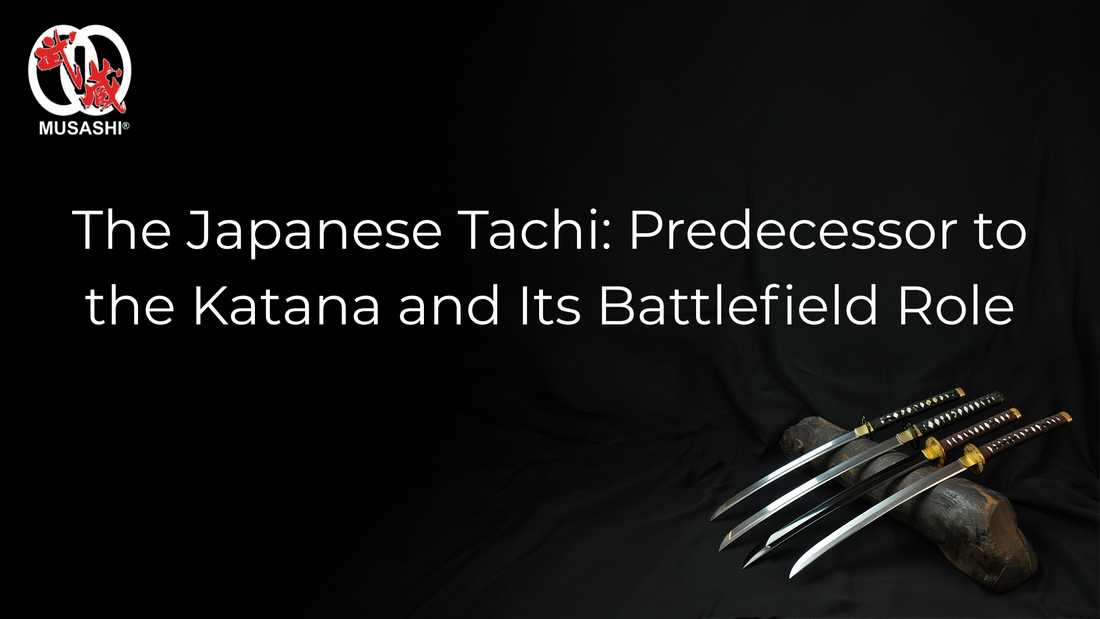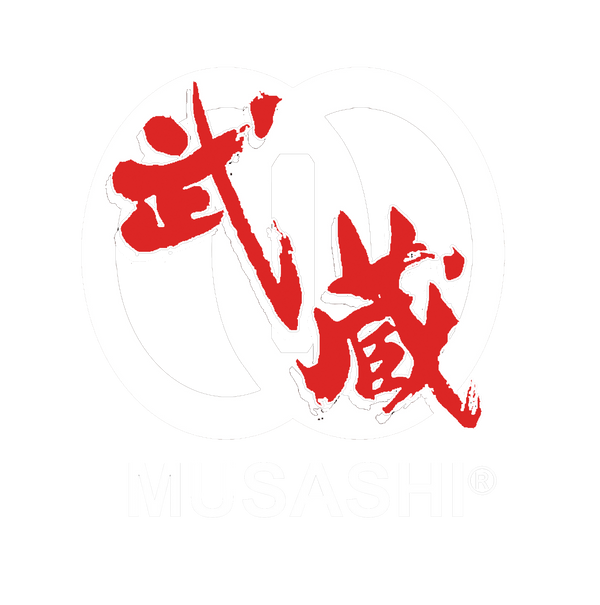
The Japanese Tachi - Predecessor to the Katana and Its Battlefield Role
Share
Japanese Tachi Swords - History, Traditional Techniques, and Role on the Battlefield
The Japanese Tachi - Predecessor to the Katana and Its Battlefield Role played a significant part in the history of Japanese swords, showcasing traditional techniques that influenced the design and use of later blades like the Katana and Odachi. Its curved shape and longer blade made it ideal for mounted warriors, defining its unique role on the battlefield.
The Japanese Tachi - A Predecessor to the Katana
The Japanese tachi is an ancestral form that paved the way for traditional katana designs, fundamentally shaping the evolution of samurai warfare. It has a curved shape and played a big part in samurai weaponry. People see it as a key step in howthe katana was made . Learning about the tachi helps us understand why the katana became so famous in Japan.
Overview of the Tachi and Its Historical Significance
The tachi appeared long ago during Japan's feudal times. It grew popular between the Kamakura period (1185-1333) and the Muromachi period (1336-1573). This sword was mainly for warriors fighting on horses.
Here's what made it special:
- Longer than katanas, about 60 to 90 cm.
- Designed for mounted combat.
- Used in battles like those during the Sengoku period.
- The curved blade helped quick drawing and powerful cuts.
The tachi served well on battlefields when horse cavalry was common. Its shape fit perfectly with how samurai fought back then.
Brief Introduction of the Katana and Its Relationship to the Tachi
Later, during periods like Edo (1603-1868), fighting styles changed. The katana came from swords like the tachi because foot soldiers became more common than horse riders.
Both swords share traits like fine steel making. But they differ in use:
- Katanas are worn edge-up for fast drawing.
- Tachis hang edge-down, showing their curved beauty.
They look alike but served different needs on and off the battlefields.
Highlighting the Tachi's Unique Characteristics and Battlefield Role
The tachi had features that made it stand out:
- Made for mounted combat on horseback.
- Great for fast strikes while staying balanced.
- The curve gave strong cutting power.
- A longer blade meant better reach in fights.
- Strong but light, easy to handle.
- Tough steel held sharp edges well.
This sword wasn't just a weapon; it showed samurai status and skill. Its design still draws interest today among sword fans and martial artists at places like Musashi Swords.
Tachi - Design and Construction
Anatomy of the Tachi
The tachi is an old Japanese sword. Samurai used it a lot because it worked well in battle. If you look at its parts, you'll see why.
- Blade (Ha): This blade curves and has one sharp edge. It usually measures from 28 to 32 inches, or about 2.5 to 3 shaku. Its curve helps samurai cut fast while riding horses.
- Tsuka (Handle): The handle is wrapped in ray skin and silk cord. It helps hold the sword firmly. Inside it, little bamboo pegs called mekugi keep the blade tight in place.
- Saya (Scabbard): This is the sword's cover made of light wood with lacquer on top. It protects the blade when not in use.
- Tsuba (Sword Guard): This guard sits between the handle and blade. It stops hands from slipping onto the blade and also looks nice.
Traditional Tachi Forging Techniques
Making a tachi uses old methods handed down by famous schools like Yamato, Yamashiro, Bizen, Sōshū, Mino—the Gokaden schools—and Soshu style masters like Amakuni Yasutsuna.
It all starts with making tamahagane steel in tatara furnaces. This steel is very pure and good for swords.
Here's how they work:
- Folding Steel: The smith folds steel many times to spread carbon evenly. This makes it strong but still flexible.
- Clay Coating & Differential Hardening: They put thick clay on some parts of one side of the blade before quenching it in water or oil. This cools parts at different speeds.
- Tempering Process: After hardening, they reheat the blade carefully to make sure it won't break easily but stays hard where needed.
Tachi in Warfare - Tactics and Effectiveness
The Japanese tachi was a favourite weapon for samurai on the battlefield. It worked best for mounted combat because of its curved blade. This shape lets riders draw it fast and slash hard while riding a horse. The tachi's length gave warriors a deadly reach. They could hit enemies before getting too close. This sword was light but strong. It balanced durability with easy handling. Samurai used it for quick strikes in horse cavalry tactics, where speed mattered a lot.
Tachi vs. Katana - A Comparative Analysis
The tachi came before the katana. Both are curved Japanese swords, but they have big differences. Tachi usually have longer blades and more curves than katanas do. That stronger curve helps slice better when drawn fast on horseback or in close fights.
Over time, samurai changed their swords. The katana grew popular because it worked well on foot. It has a shorter blade and less curve than the tachi. The katana also made drawing quicker from the waist, which helped in fast sword moves like iaijutsu.
The Tachi and the Samurai Spirit
The tachi is one of the oldest samurai swords in Japanese sword heritage.It came before the katana and has a longer, curved blade. Samurai used it mainly on horseback because its shape worked well for riding and fighting. The sword shows the Bushido spirit—the samurai honour code that values loyalty, courage, and discipline.
Over time, the tachi gained prestige as a symbol of samurai culture. Warriors respected it because it reminded them of their duties and moral strength. Every curve on the sword seemed to tell a story about dedication and honour that never fades.
Here's what the tachi stands for:
- Japanese sword heritage
- Bushido spirit
- Samurai honour code
- Spiritual protection
- Samurai prestige
- Tradition and valour
- Timeless design
The Legacy of the Tachi - Mythology and Tradition
The tachi's story goes beyond battlefields into samurai folklore and myths. Japanese swordsmiths made these blades with great care. Some even said their swords had spiritual powers. Myths add another layer to the tachi's meaning. Some stories say the gods blessed certain swords. Others tell of heroes who used them in battles filled with honour and strength. These tales mix fact with legend and make people admire the swords even more.
Acquiring and Appreciating a Tachi
Understanding the Value and Authenticity of a Tachi
A tachi is a kind of traditional Japanese sword made by skilled Japanese swordsmiths. These swords fall under nihontō, meaning they are authentic Japanese swords. The tachi has a curved blade and looks different from the katana.It was mainly used by cavalry warriors long ago.
People don't just admire a tachi for how it looks. They also learn about its culture and respect how it was made. Keeping a tachi in good condition helps keep its story alive while honouring old traditions.
Exploring the Musashi Swords Collection
Musashi Swords offers an impressive authentic Tachi collection that highlights the rich heritage and craftsmanship of these traditional blades. Each sword mixes traditional craft with modern skill to meet what collectors want. Musashi Swords cares about customer experience, too.They give clear info on each sword's origin, materials, and how to care for it.This helps people new to nihontō or those who already collect understand better. By keeping respect for tradition and making things easy to learn about, Musashi Swords invites more people to enjoy authentic Japanese swords without losing quality or honesty.
The Enduring Appeal of the Tachi
The Japanese tachi is a special sword with a rich history. It has an elegant curve and a sharp, refined blade design. Samurai used it mostly on battlefields, especially when they fought on horseback.
Its shape made it easier to swing while riding fast. But the tachi is more than just a weapon. It stands for samurai culture and spirit. This sword shows honour and tradition. Even today, many people admire its timeless design and deep cultural meaning.
Recap of Key Aspects - History, Design, and Cultural Impact
The tachi blade features a smooth, elegant curve. This curve helps the sword cut well and look beautiful at the same time. Unlike the katana, which has a straighter edge for fighting on foot, the tachi's big curve suits open battlefield fights. The design is both useful and artistic.
Here are some key points about the tachi's design and history:
- It has a longer, curved blade for slashing from horseback.
- Its polished surface shows fine craftsmanship.
- It was a status symbol for samurai long ago.
- Its unique style influenced later swords but kept its own look.
Explore Authentic Japanese Swords with Musashi Swords
If you want to learn about authentic Japanese swords or collect real pieces inspired by history, Musashi Swords is a good place to start. We offer swords made with care that reflect traditional craftsmanship. Musashi Swords makes these classic designs available beyond just expert collectors. Each hand-forged sword links you to old traditions filled with skill and pride.
FAQs
What is the tachi classification in Japanese swords?
Tachi classification refers to the categorisation of swords based on their length, curvature, and use in battle. Tachi are longer and more curved than katanas, designed mainly for mounted combat.
How does blade curvature physics affect the tachi's cutting efficiency?
The deep curve of the tachi allows smoother slicing cuts. This shape lets samurai deliver powerful strikes while on horseback with less resistance.
What sword symbolism does the tachi hold for the samurai?
The tachi symbolises samurai honour, status, and spiritual protection. It represents tradition and the Bushido spirit deeply ingrained in samurai culture.
How was Japanese sword measurement done historically?
Lengths were measured in shaku, sun, and bu. One shaku equals about 30.3 cm. These units helped smiths craft blades to precise sizes.
Why is sword polishing important for a tachi?
Polishing reveals the hamon pattern and hada grain. It sharpens the blade and protects it from rust, enhancingbeauty and value.
